
Scaevola is a genus of flowering plants in the Goodenia family, Goodeniaceae. It consists of more than 130 species, with the center of diversity being Australia and Polynesia. There are around 80 species in Australia, occurring throughout the continent, in a variety of habitats. Diversity is highest in the South West, where around 40 species are endemic.

Leucopogon is a genus of about 150-160 species of shrubs or small trees in the family Ericaceae, in the section of that family formerly treated as the separate family Epacridaceae. They are native to Australia, New Zealand, New Caledonia, the western Pacific Islands and Malaysia, with the greatest species diversity in southeastern Australia. Plants in this genus have leaves with a few more or less parallel veins, and tube-shaped flowers usually with a white beard inside.
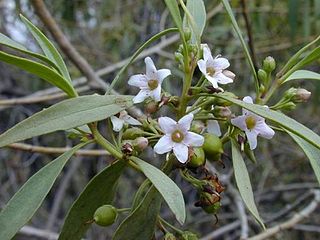
Myoporum is a genus of flowering plants in the figwort family, Scrophulariaceae. There are 30 species in the genus, eighteen of which are endemic to Australia although others are endemic to Pacific Islands, including New Zealand, and one is endemic to two Indian Ocean islands. They are shrubs or small trees with leaves that are arranged alternately and have white, occasionally pink flowers and a fruit that is a drupe.

Dodonaea is a genus of about 70 species of flowering plants, often known as hop-bushes, in the soapberry family, Sapindaceae. It has a cosmopolitan distribution in tropical, subtropical and warm temperate regions of Africa, the Americas, southern Asia and Australasia. By far the highest species diversity is in Australia. The genus is named after Rembert Dodoens, traditionally known as 'Dodonaeus'.

Banksia sect. Oncostylis is one of four sections of subgenus Banksia subg. Banksia. It contains those Banksia species with hooked pistils. All of the species in Oncostylis also exhibit a top-down sequence of flower anthesis, except for Banksia nutans which is bottom-up.

Gastrolobium is a genus of flowering plants in the family Fabaceae. There are over 100 species in this genus, and all but two are native to the south west region of Western Australia.

Gompholobium, commonly known as glory peas or wedge-peas, is a genus of plants in the pea family, Fabaceae and is endemic to Australia. Most species have compound leaves composed of three leaflets and all have ten stamens which are free from each other and a distinctive arrangement of their sepals.
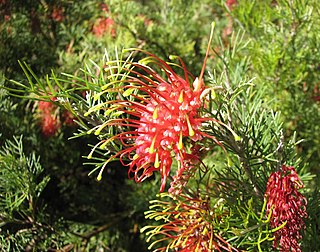
Grevillea thelemanniana, the spider-net grevillea or hummingbird bush, is a small, spreading shrub endemic to Western Australia.

Grevillea vestita is a shrub which is endemic to the south-west of Western Australia.
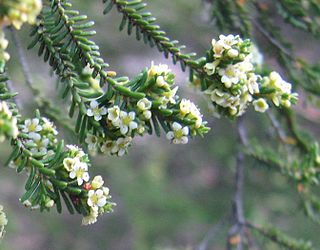
Micromyrtus is a genus of shrubs, in the family Myrtaceae, described as a genus in 1865. The entire genus is endemic to Australia.

Senna artemisioides, the wormwood senna, is a species of flowering plant in the pea family Fabaceae. It is endemic to Australia, where it is found in all mainland states and territories. Other common names include silver senna, silver cassia or feathery cassia - although "cassia" generally refers to the largest-growing Cassiinae. Some of its distinct subspecies also have common names of their own.
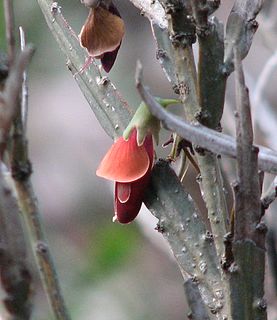
Bossiaea is a genus of flowering plants in the pea family Fabaceae, consisting of about 70 species which are native to Australia. The genus is named in honour of Joseph Hugues Boissieu La Martinière, a botanist on La Pérouse's expedition to Australia.

Lasiopetalum, commonly known as velvet bushes, is a genus of about forty-five species of flowering plants in the family Malvaceae, all endemic to Australia.

Daviesia, commonly known as Bitter-peas, is a large genus of flowering plants in the legume family. They are native to Australia, with a centre of diversity in Western Australia.

Calytrix is a genus of shrubs in the family Myrtaceae described as a genus in 1806. They are commonly known as starflowers. Calytrix are endemic to Australia, occurring in the.

Dodonaeoideae is a subfamily of flowering plants in the soapberry family, Sapindaceae.

Adenanthos sect. Eurylaema is a taxonomic section of the flowering plant genus Adenanthos (Proteaceae). It comprises four species, all of which are endemic to southwest Western Australia.
Adenanthos filifolius is a species of erect shrub endemic to southwest Western Australia. It was first described by George Bentham in 1870.
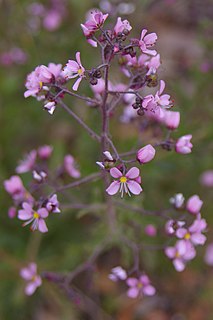
Diplopeltis hueglii is a shrub species in the soapberry family, Sapindaceae. It is endemic to Western Australia. Plants grow to between 0.1 and 1.5 metres high. White, pink or purple flowers are produced between April and December in the species' native range.
Xylomelum benthamii is a plant in the woody pear genus of the family Proteaceae. It was formerly considered a variety of Xylomelum pyriforme. It is native to south-eastern Queensland, Australia, and was described from material collected on 25 June 1829 on the Brisbane River some 140 km north-west of what is now Brisbane, the state capital. It was mistakenly linked with the name Xylomelum salicinum (Meisn.) Benth., and was given the replacement name X. benthamii in 2007 by A.E. Orchard, with the specific epithet honouring botanist George Bentham.


















